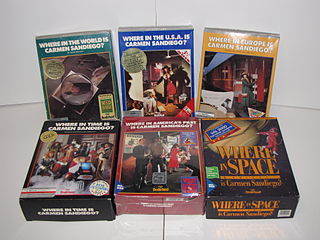
Carmen Sandiego is a series of American educational mystery video games that spawned an edutainment franchise of the same name. The game released in 1985, Where in the World Is Carmen Sandiego?, started off both the video game series and the franchise as a whole, which has continued up to the present day. Each game of the series has a particular theme and subject, where the player must use their knowledge to find Carmen Sandiego or any of her innumerable henchmen. This series was originally owned by Broderbund, but is now owned by Houghton Mifflin Harcourt. Since its initial release the series has won over 125 awards and accolades.

3D Lemmings is a 1995 puzzle video game developed by Clockwork Games and published by Psygnosis. The gameplay, like the original Lemmings game, requires the player to lead all the lemmings to their exit by giving them the appropriate "skills". It was the first Lemmings game to be rendered in 3D. It was released for DOS, PlayStation, and Sega Saturn.
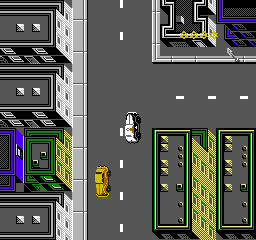
Dick Tracy appeared in the following video game tie-ins for the motion picture:
They Stole a Million is a strategy computer game released by Ariolasoft in 1986. The objective of the game is to plan robberies and execute the crime. The player first purchases blueprints of the house where the soon-to-be-stolen object is kept. Then several specialists can be hired which disable alarms, open locks or drive the getaway car.

Beetle Adventure Racing! is a racing game released for the Nintendo 64 in 1999. It was developed by Paradigm Entertainment and EA Canada, and published by Electronic Arts. Each vehicle in the game is a Volkswagen New Beetle, which was released the previous year. The gameplay involves racing other players on unlocked tracks, finding and destroying crates, and collecting colored ladybugs while battling other players. The single-player championship offers three circuits and a secret bonus circuit with new vehicles and tracks available upon completion.

Obitus is an action-adventure game developed and released by Psygnosis in early 1991 for Amiga, Atari ST and DOS. It was also ported to the Super Nintendo Entertainment System by Bullet-Proof Software. The game features both first-person dungeon crawling and side-scrolling gameplay with action-oriented combat and an emphasis on item acquisition. It is similar to games like Eye of the Beholder on Super Nintendo but without the RPG mechanics.

Kwirk, known in Japan as Puzzle Boy, is a puzzle video game developed and published by Atlus in Japan on November 24, 1989, for the Game Boy. The game was later published in North America in March 1990 by Acclaim Entertainment.

The Sims 3 is a 2009 life simulation video game developed by the Redwood Shores studio of Maxis, and published by Electronic Arts. Part of The Sims series, it is the sequel to The Sims 2. It was released on June 2, 2009, for Mac OS X, Microsoft Windows, and smartphone versions. Console versions were released for PlayStation 3, Xbox 360, and Nintendo DS in October 2010 and a month later for Wii. The Windows Phone version was released on October 15, 2010. A Nintendo 3DS version, released on March 27, 2011, was one of the platform's launch titles.
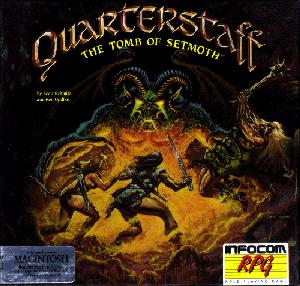
Quarterstaff: The Tomb of Setmoth is an interactive fiction role-playing video game developed by Scott Schmitz and Ken Updike and released by Infocom for Macintosh in 1988. The game features a text parser, graphics, a dynamically updated map, and a graphical interface that incorporates Mac OS hierarchical menus.

Police Quest: In Pursuit of the Death Angel is a 1987 police procedural adventure video game developed and published by Jim Walls and Sierra On-Line. Police Quest follows police officer Sonny Bonds as he investigates a drug cartel in the town of Lytton, California.

Scooby-Doo Mystery is the name of two video games released by Acclaim Entertainment in 1995 and licensed by Sunsoft based on the Scooby-Doo animated series. One of the games was released for the Sega Genesis and features a more traditional adventure game-style interface. The other title, released for the Super Nintendo Entertainment System, is an adventure game with platforming elements. Both were released only in North America. In both games, players take control of Shaggy Rogers and Scooby-Doo, who help solve various mysteries with other members of Mystery Incorporated who serve minor roles during gameplay.
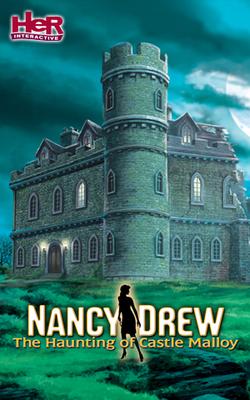
The Haunting of Castle Malloy is the 19th installment in the Nancy Drew point-and-click adventure game series by Her Interactive. The game is available for play on Microsoft Windows platforms. It has an ESRB rating of E for moments of mild violence and peril. Players take on the first-person view of fictional amateur sleuth Nancy Drew and must solve the mystery through interrogation of suspects, solving puzzles, and discovering clues. There are two levels of gameplay, Junior and Senior detective modes, each offering a different difficulty level of puzzles and hints, however neither of these changes affect the plot of the game. The game is loosely based on the book The Bike Tour Mystery (2002).
An adventure game is a video game genre in which the player assumes the role of a protagonist in an interactive story, driven by exploration and/or puzzle-solving. The genre's focus on story allows it to draw heavily from other narrative-based media, such as literature and film, encompassing a wide variety of genres. Most adventure games are designed for a single player, since the emphasis on story and character makes multiplayer design difficult. Colossal Cave Adventure is identified by Rick Adams as the first such adventure game, first released in 1976, while other notable adventure game series include Zork, King's Quest, Monkey Island, Syberia, and Myst.

The Sting! is a strategy/adventure video game developed by Neo Software and released by JoWooD Productions on 1 July 2001. It is the sequel to 1994's The Clue!.
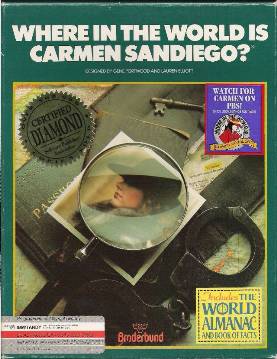
Where in the World Is Carmen Sandiego? is an educational video game released by Broderbund on April 23, 1985. It is the first product in the Carmen Sandiego franchise. The game was distributed with The World Almanac and Book of Facts, published by Pharos Books. An enhanced version of the game was released in 1989, which did not have the almanac-based copy protection and instead used disk-based copy protection. A deluxe version was released in 1990, and featured additional animation and a reworked interface from the original version. Some of the bonus features included digitized photos from National Geographic, over 3200 clues, music from the Smithsonian/Folkways Recordings, 20 villains, 60 countries, and 16 maps. CD-ROM versions for DOS and Macintosh were released in 1992, and a Windows version was released in 1994.

Carmen Sandiego Adventures in Math is a series of five games released in 2011/2012 for the Wii, and is part of the Carmen Sandiego franchise. The style of the games are reminiscent of comic books. The 5-part series were the first English language console games from the Carmen Sandiego franchise since The Secret of the Stolen Drums. These "short, educational detective adventures" were only available as a download through the Nintendo Wii Shop. The games were developed by Gamelion Studios, and published by Houghton Mifflin Harcourt. They could take up to 6 players, and required 600 Wii points. Maths topics included in the games include: Symmetry, Identifying angles, Graphing coordinates on a grid, Logic puzzles, Working with fractions, Solving equations, and Tangrams. The games are designed for elementary learners across grades 3–5.

Disney Infinity is a 2013 toys-to-life action-adventure game published by Disney Interactive Studios. It was announced on January 15, 2013. The game used collectible figurines that were then synchronized with the game, unlocking characters from Disney and Pixar properties that interact and go on adventures. The game was released for Xbox 360, PlayStation 3, Wii, Wii U, and Nintendo 3DS in August 2013. A PC version of Toy Box was also released on November 14, 2013. The game had a budget approaching $100 million. A sequel, Disney Infinity 2.0, was released on September 23, 2014. The third edition, Disney Infinity 3.0, was released on August 30, 2015, and introduced support for the Apple TV. This game was also later released on Microsoft Windows in 2013.
This is a non-comprehensive list that includes terms used in video games and the video game industry, as well as slang used by players.

Killed Until Dead is an adventure game developed by Artech and published by Accolade in 1986. It was released on Apple II, Amstrad CPC, Commodore 64, and ZX Spectrum.

















